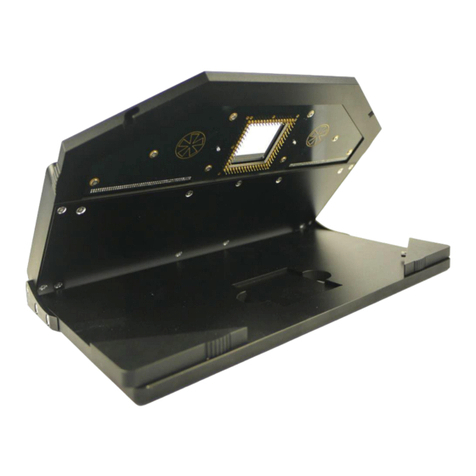
MEA Amplifier for Inverse Microscopes Manual
10
3.2 Setting Up and Connecting the MEA Amplifier
Warning: Spilled liquid can damage or even completely destroy the electronics of the MEA
amplifier. Please be extremely careful when setting up your perfusion system and when starting
the perfusion. Take care that the flow rates of the inlet and outlet flow match so that flooding
of the amplifier is efficiently prevented.
Note: The housing of the MEA amplifiers was optimized for Zeiss Axiovert microscopes. MEA
amplifiers are compatible to most standard microscopes if the following prerequisites are met.
This MEA amplifier type has been developed for standard inverse microscopes with a rectangular
microscope table. The focal plane of the microscope has to be in a distance of 3.5 mm to the
microscope table.
Note: If you use a complete MEA-System, the MEA amplifier will usually be powered by the
isolated power supply (IPS10W) that is integrated into the data acquisition computer. The power
is distributed along the MCS 68-pin MCS high grade cable. If you use your MEA amplifiers
together with a MEA Switch, or if you use a custom data acquisition system without IPS10W,
you will need an external power supply for operating the amplifier(s). Please ask your local
retailer for more information on setup options.
Note: If you use an USB-ME-System you need an external power supply, for example a PS40W,
for operating the amplifier(s). Please ask your local retailer for more information on setup
options.
Using the MC_Card for data acquisition: Connect the MEA amplifier's output to the MC_Card
input labeled MC_Card Ch. 01–64 with a 68-pin MCS standard cable. If you have a MEA120-System,
connect the second MEA amplifier with a 68-pin MCS standard cable to the input for channels
65 –128 labeled MC_CX64 Ch. 65 –128. If you are using a MEA Switch, connect the amplifiers to
the MEA Switch inputs, and the MEA Switch outputs to the MC_Card.
Using an USB-ME data acquisition device: Connect the MEA amplifier's output to the USB-ME
input via 68-pin MCS standard cable. If you are using a MEA Switch, connect the amplifiers to
the MEA Switch inputs, and the MEA Switch outputs to the USB-ME device.
1. Place the MEA amplifier onto the microscope table.
2. Connect the internal heating element to a Temperature Controller's output channel (D-Sub9
socket) with the black cable. (The Temperature Controller is not part of the standard scope of
delivery, but is included in the MEA-System or USB-ME-System, and can also be ordered
separately.) Do not connect the black heating element cable to the data acquisition computer.
3. You should use a Faraday cage or appropriate materials, for example aluminum foil, for shielding
the amplifier. The shielding should be connected to the amplifier's ground, for example, to the
screws of the cover.
Please see also the separate handout "MEA Microelectrode Systems" for setup suggestions with
detailed illustrations.




























